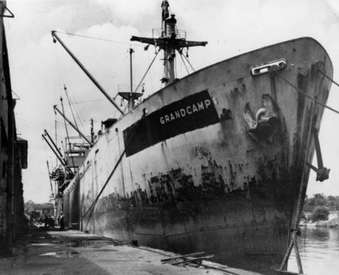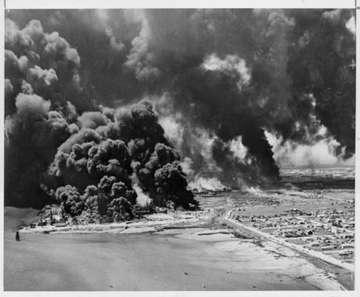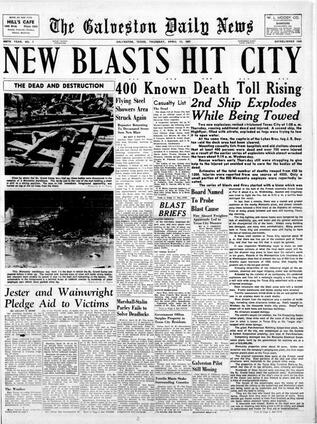Texas City Port
Source: Houston Chronicle, circa April 1947
Source: Houston Chronicle, circa April 1947
City on Fire
"Everywhere you turned, there was nothing but fire."
-Gordon Holt, Survivor of the Texas City Disaster1
-Gordon Holt, Survivor of the Texas City Disaster1
|
On April 16th, 1947, two French ships entered the port at Galveston Bay in Texas City. Soon after entering the harbor, smoke was spotted coming from the SS Grandcamp, a ship loaded with nearly 2,000 tons of fertilizer. The fire and the attempts to put it out garnered the attention of the city’s fire department and many spectators near the dock.
|
SS Grandcamp
Source: Houston Chronicle, April 1947. |
"It was so black, we couldn't see nothing… I thought we'd choke to death because there was so much smoke."
-Gordon Holt, Survivor of the Texas City Disaster2
-Gordon Holt, Survivor of the Texas City Disaster2
|
Giant smoke clouds from one of the largest non-nuclear explosions in history.
Source: Houston Chronicle, April 1947. |
"At 9:12 a.m., flames shot from the Grandcamp's open hatch and a deafening blast ... blew the ship to pieces, sending a cloud of dense black smoke thousands of feet into the air and scattering the ship's remains across the city. The 2-ton anchor landed more than mile away."3
|
|
The first explosion was so powerful, it registered on seismographs in Denver, Colorado, 1,000 miles away. People in Louisiana also felt the shock, 250 miles away. The nearby Monsanto Chemical Company along with oil and chemical storage tanks were set on fire causing more chaos.
|
|
Aftermath of the Texas City Disaster
Source: Houston Chronicle & Moore Memorial Public Library, April 1947
Source: Houston Chronicle & Moore Memorial Public Library, April 1947
“Looking towards the docks, I saw black, ragged things flying through the air like buzzards. Then I realized they were parts of the ship and debris, deadly shrapnel of various sizes”
-William Hadley, Survivor of the Texas City Disaster4
-William Hadley, Survivor of the Texas City Disaster4
|
News headline on the initial estimated death toll. Source: The Galveston Daily News, April 17, 1947
|
After the tragedy, approximately 570 people died and several thousand more were injured. The exact number of lives lost can’t be known and might actually be much higher. Most bodies were difficult to identify and some were never found, including all 28 members of the Texas City Fire Department.
|
|
Video footage of a store with its windows blown out from the impact of the explosions. Source: ABC 13 Eyewitness News, April 1947
|
Footnotes:
1. We Were There: a Collection of the Personal Stories of Survivors of the 1947 Ship Explosions in Texas City, Texas, Commonly Referred to as the Texas City Disaster. [Texas City. Tex.] : [Mainland Museum of Texas City], [1997], 1997.
2. Ibid.
3. Sims, Patsy. “The Day the Windows Shook.” Texas Observer, 2018, pp. 36–37.
4. We Were There: a Collection of the Personal Stories of Survivors of the 1947 Ship Explosions in Texas City, Texas, Commonly Referred to as the Texas City Disaster. [Texas City. Tex.] : [Mainland Museum of Texas City], [1997], 1997.
1. We Were There: a Collection of the Personal Stories of Survivors of the 1947 Ship Explosions in Texas City, Texas, Commonly Referred to as the Texas City Disaster. [Texas City. Tex.] : [Mainland Museum of Texas City], [1997], 1997.
2. Ibid.
3. Sims, Patsy. “The Day the Windows Shook.” Texas Observer, 2018, pp. 36–37.
4. We Were There: a Collection of the Personal Stories of Survivors of the 1947 Ship Explosions in Texas City, Texas, Commonly Referred to as the Texas City Disaster. [Texas City. Tex.] : [Mainland Museum of Texas City], [1997], 1997.
|
John Castaneda, Nicolas Gonzales, Soraida Sosa, Isaac Veloz
Senior Group Website Website Student Generated Words: 1152 Process Paper Student Generated Words: 484 Media Duration: 3:45 |
Best viewed at resolutions
of 1280 x 1024 or greater on Google Chrome |


